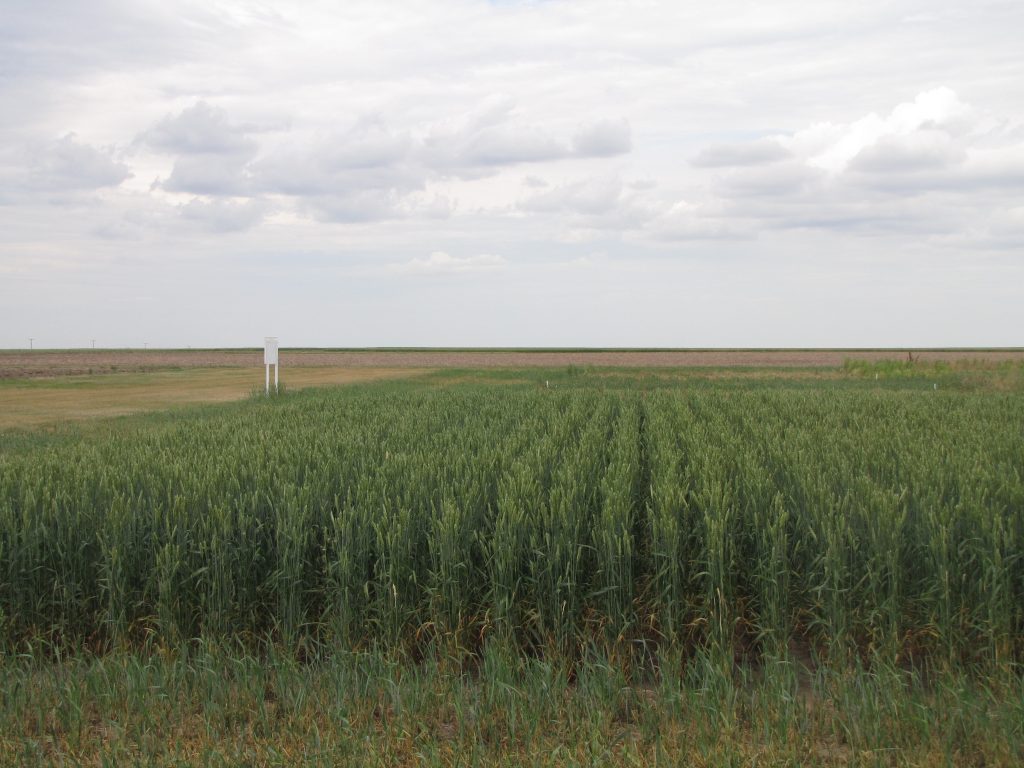
Features
Agronomy Update
Agronomy
Cereals
Is wider row spacing in wheat possible?
May 20, 2021 By Bruce Barker, P.Ag CanadianAgronomist.ca
 Photo courtesy of the Organic Research Program at AAFC Swift Current Research and Development Centre (SCRDC).
Photo courtesy of the Organic Research Program at AAFC Swift Current Research and Development Centre (SCRDC). Wider row spacing can lead to reduced capital costs by eliminating shanks and reduced operating costs with lower draft requirements. But it is a balance with many different factors, including potential issues of seedling fertilizer burn, increased weed pressure and yield and quality impacts.
A four-year study was conducted from 2013 through 2016 at the Agriculture and Agri-Food Canada Research Farm in Indian Head, Sask., to determine the effects of row spacing and rate of nitrogen (N) fertilizer on the establishment, crop development, yield, N uptake, and quality of spring wheat.
The treatments were four row spacings of 10, 12, 14 and 16 inches (25, 30, 35 and 40 centimetres). Five fertilizer nitrogen (N) rates were applied at 18, 36, 71, 107 and 142 pounds of nitrogen per acre (lbs. N/ac), or 20, 40, 80, 120 and 160 kilograms of nitrogen per hectare (kg N/ha) of urea.
A fertilizer blend with an analysis of 14-20-10-10 was side-banded across all treatments at a rate of 127 lbs. N/ac (143 kg/ha). The quantity of urea used for the five different N rates was adjusted to accommodate the N present in the 14-20-10-10 fertilizer blend.
The residual N and P prior to seeding ranged from 21 to 42 lbs. N/ac (24 to 48 kg N/ha). The target seeding density of Goodeve wheat was 25 plants/ft² (250 plants/m2), and was seeded into canola stubble with a no-till drill with shank openers. The fertilizer band was located 1.5 inches to the side and 0.75 inches below the seed
Seeding depth was approximately 0.75 inches (19 mm) under the soil surface at the bottom of a 1 to 1.3 inch (25 to 33 mm) groove cut into the soil by the no-till shank opener.
In 2013 and 2015, increasing row spacing decreased plant density. In both of these years, precipitation was below normal, especially in May. There was a linear decrease in plant density from 26 to 20 plants/ft2 as row spacing widened in 2013. In 2015, there was a curvilinear decrease in plant density from 21 to 16 plants/ft2 as row spacing increased, with the greatest decrease occurring between the 10- and 12-inch row spacings.
Plant density was not affected by N rate. This indicates that as N rate increased, the separation of seed and fertilizer was maintained. Additionally, there was not an interaction between N and row spacing. This indicates that the reduced plant density observed as the row spacing increased two out of four times (213 and 2015) is due to factors other than N fertilizer rate. The researchers thought that interplant competition, especially under stressful environmental conditions in the seed row, could be the reason.
Row spacing alone did not impact the number of tillers per plant. There was a small linear increase in the number of tillers with increasing N rate, rising from 1.2 tillers per plant at 18 lbs. N to 1.6 tillers per plant at 142 lbs. N. The researchers indicated that this showed that the yield potential was not maximized by just the plant density, and the crop was continuing to respond to increasing rates of N through increased tillering. Increases in tillering were seen in drier years when the crop was compensating for lower plant densities.
In each test year, there was a curvilinear increase in grain yield as the N rate increased. The largest increase occurred in 2014 when grain yield climbed from 38 to 64 bu/ac (2,569.8 to 4,273.3 kg/ha), while the smaller increase occurred in 2016, when grain yield increased from 41 to 52 bu/ac (2,781.3 to 3,518.5 kg/ha). Overall, grain yield increased by the greatest proportion each year when the N rate increased from 37 to 71 lbs. N/ac (40 to 80 kg N/ha).
Row spacing did not significantly affect yield except in the dry year of 2013, when yield decreased as row spacing increased from 10 to 16 inches, with the largest decrease occurring between 12 and 14 inches, when grain yield dropped from 70 to 58 bu/ac (4,705.8 to 3,900.0 kg/ha). This indicates that as row space increased in this drier-than-normal year, other yield components such as increased tillering could not compensate for the lower plant densities that occurred in 2013.
There was no interaction between row spacing and N rate on yield.
These results show that, while there is potential for wider row spacing, there was a 25 per cent probability of lower yield with wider row spacing, which occurred in an abnormally dry year. The limitations of just four site-years of data also create uncertainty about the benefit of moving to a wider row spacing beyond 10 to 12 inches. Producers need to weigh the risk of a potential yield decrease against the cost savings derived by increasing the row spacing.
 Bruce Barker divides his time between CanadianAgronomist.ca and as Western Field Editor for Top Crop Manager. CanadianAgronomist.ca translates research into agronomic knowledge that agronomists and farmers can use to grow better crops. Read the full Research Insight at CanadianAgronomist.ca.
Bruce Barker divides his time between CanadianAgronomist.ca and as Western Field Editor for Top Crop Manager. CanadianAgronomist.ca translates research into agronomic knowledge that agronomists and farmers can use to grow better crops. Read the full Research Insight at CanadianAgronomist.ca.